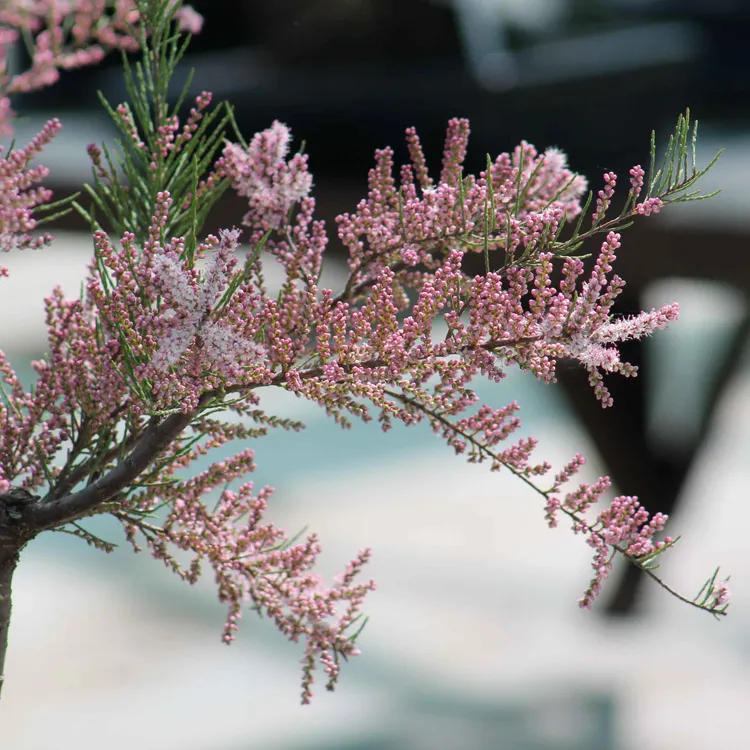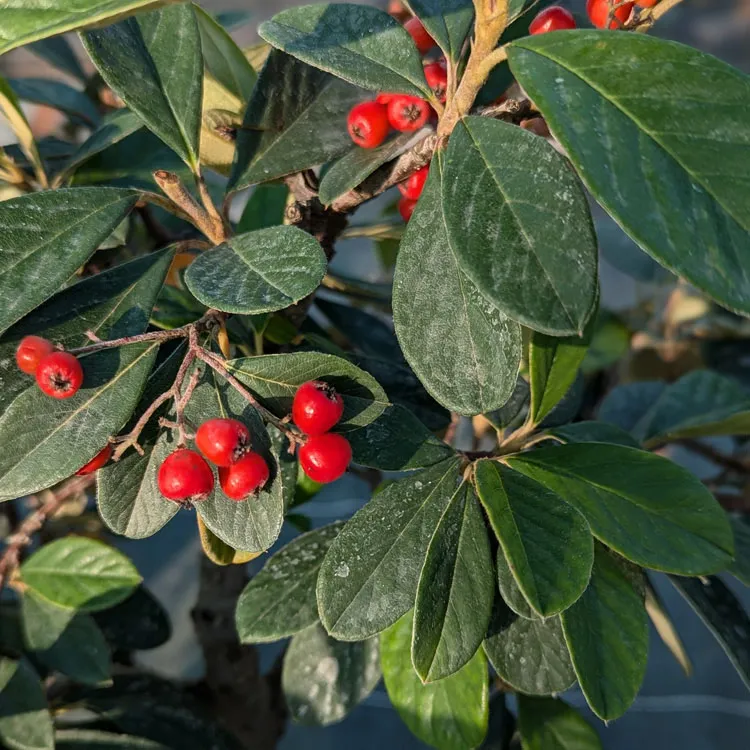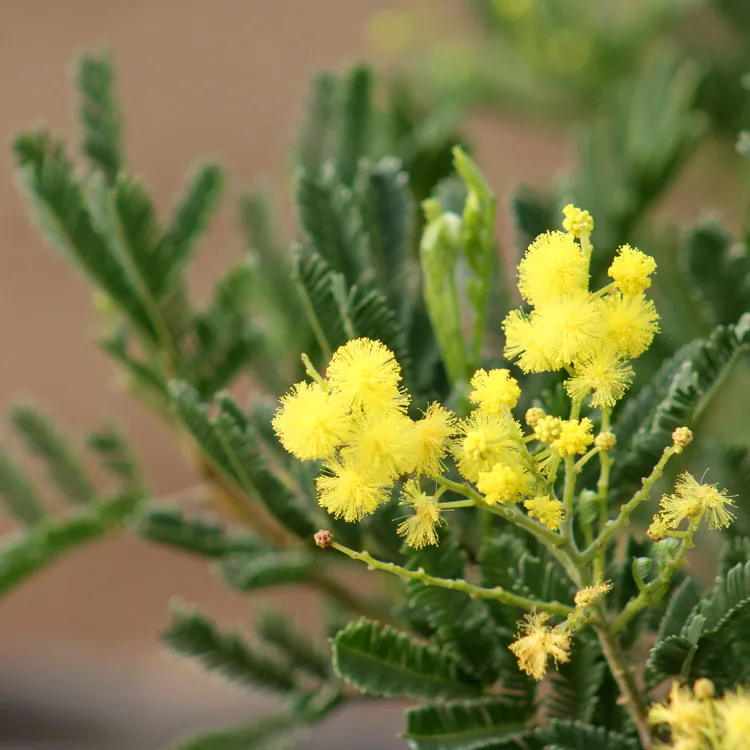When we think of bonsai, Japanese maples often come in the top 3 answers. And that's not surprising because they're gorgeous, easy to grow, and grow fast. On the other hand, there is not just one type of maple, but several species and hundreds of varieties that differ in the shape and colour of the leaves, among other things.
Maple trees, beautiful bonsai all year round
There are few trees whose appearance changes so much with the seasons. For the Japanese, it is the feminine tree par excellence, they say that, like women, they regularly change their clothes. The more macho also say that they are like women, moody, but that's another debate!
While some are remarkable at a certain time of year, maple trees are beautiful in all seasons:
- In spring, the first leaves are coloured in shades ranging from yellow to red to orange or pink, depending on the variety
- In summer, they are covered with delicate leaves whose slight transparency allows the sun's reasons to pass through. In fact, in Japan, many people walk in the gardens to admire the play of light through the leaves of the maple trees
- In autumn, the festival of colours resumes with shades ranging from orange to red
- In winter, the fallen leaves reveal the fine branching. This is where you can see all the work of the bonsaika which, year after year, has carefully pruned the branches to obtain a beautiful and dense branching. In the major Japanese exhibitions, the maple trees are displayed in winter, so that you can admire this delicate work
Bonsai maple is really what we advise for beginners as it is a very rewarding tree that is pleasing to the eye every time you walk past it.
» See all our maple bonsai trees
What are the different types of maple trees?
The family is rich and complex, and it would take pages to make an exhaustive list. First of all, there are our native maples, such as the field maple or the Montpelier maple. Even though it is possible to make bonsai from them, they also do not have the finesse of Asian varieties. Their leaves are larger and the colors less flamboyant.
In this article we will focus on Asian varieties, which grow naturally in eastern China, Japan or Korea. Some varieties are obtained by grafting, which is sometimes the only way to propagate them while maintaining the characteristics of the foliage and good vigour of the tree.
Palmatum Maple
Under this name there are actually dozens of varieties, they are in common the shape of their leaves which is called "palmate", they look a bit like the fingers of a hand, and they can be more or less cut.
- The palmatum maple is the so-called stem variety, and is often used as a rootstock for other varieties. It is the strongest and most vigorous. In a few years it is possible to obtain a good-sized trunk with a nice branch structure. Its foliage is pinkish-green in spring, and turns red in autumn;
- The Palmatum Deshojo maple is remarkable for the deep red color of its leaves in spring. In addition, this color lasts longer than on the strain variety, which turns green quite quickly. On the other hand, the Deshojo is more afraid of the sun, it will need extra protection during the summer
- The Palmatum Kiyohime maple is characterized by a natural ball-shaped shape as it has a basal tendency. That is to say, it is the lower branches that are the most vigorous, while the other maples have an apical tendency and it is the head that is the strongest. In spring, the leaves are reddish and in autumn they take on hues ranging from yellow to orange (see our article on caring for a Kiyohime maple).
- The Palmatum Kotohime maple is ideal for those who want to train small bonsai. It naturally makes small leaves and short internodes. They are pink in spring, green in summer, and turn light yellow with orange-red tinges in autumn.
- The Palmatum Shishigashira maple has small leaves with short petioles growing very tightly along the branches. Its port is very compact. In spring, the foliage is a tender green before taking on a deeper hue during the summer. In the fall, you can enjoy more shimmering colors ranging from yellow to red to various shades of orange.
- The Palmatum Seiryu maple has very pretty deeply cut foliage of a bright green in spring, which turns golden yellow to orange in autumn. In winter, its highly decorative twigs are red, then turn red-brown.
- The Palmatum Kamagata maple has green leaves with pinkish-brown tips in the spring. They turn scarlet-red orange in autumn. The dense and small foliage makes it possible to form low-height bonsai.
- The Palmatum Beni Komashi maple has waffle-like foliage, pinkish-red that turns reddish-brown in the summer and then mottled with brown in the fall. It is a delicate variety to grow, it must be protected especially from heavy rains and the scorching sun.
- The Palmatum Butterfly maple will seduce you with its variegated, slightly serrated foliage. The young shoots are tinged pink in the spring. During the summer, green and creamy white are omnipresent. In autumn, the variegation turns purplish-pink and orange-yellow.
- The Palmatum Red Wood maple is characterized by its bright red wood that is very decorative in winter. Its foliage is soft green to yellow in spring, then green in summer, and finally golden yellow to orange in autumn.
- The Atropurpureum maple has beautiful foliage that stays colorful throughout the season. It is light purple-red in spring, darker in summer and then turns bright carmine red in autumn.
- The Orange Dream maple is flamboyant with its bright orange spring foliage, then light green in the summer to finish yellow edged with orange and bright in the fall. The wood of the young shoots is orange and then brown.
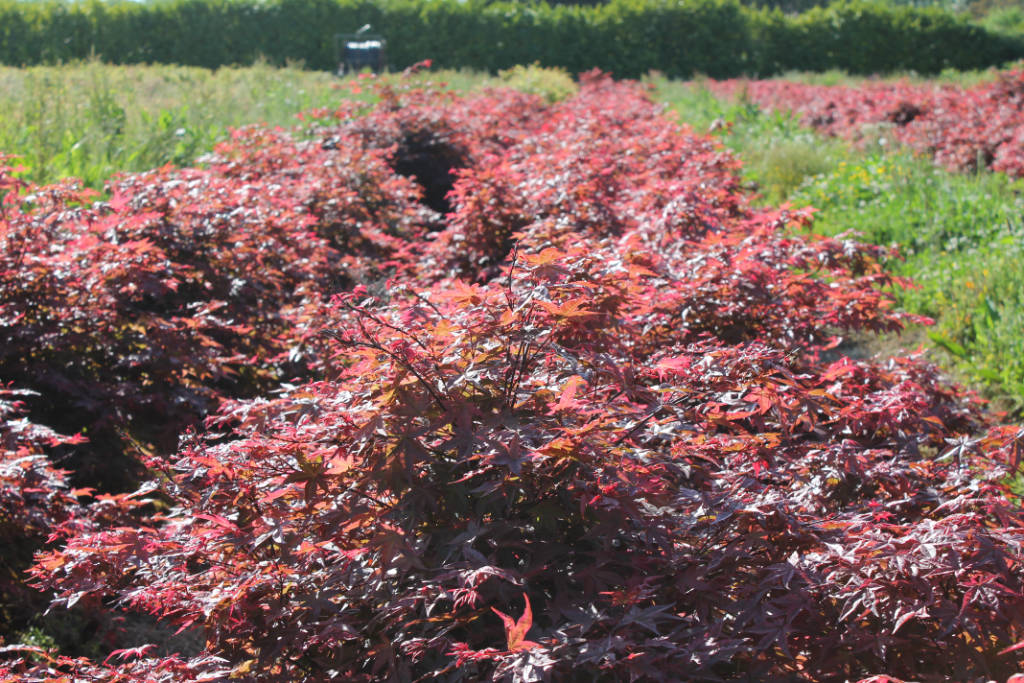
Burger maple, or trident maple
Its name also comes from the shape of its leaves, which are formed by 3 lobes ; They are also referred to as three-lobed leaves. At the beginning of the vegetation, the foliage takes on a delicate bronze color, which can change to dark green to orange-yellow red in the fall.
Burger maple is a little more resistant to the sun than Palmatum but it is less hardy. It will need to be protected in winter as soon as temperatures drop below -3°C.
It also has the advantage of making shorter internodes, so the formation of a thin branching is simpler than with Palmatum which tend to make long internodes if you are not careful.
For more information, see our Burger Maple Data Sheet.
How do you grow a Japanese maple tree as a bonsai?
It is an easy tree to grow but has its own peculiarities. By following these practical growing tips.
Where to place your maple tree?
This is the essential point, because maples are naturally species of undergrowth, they grow in the shelter of large trees that provide them with shade and protect them from the wind. The scorching sun and especially the hot winds tend to burn the leaves. This won't put the life of your maple tree into bonsai, but it will be weakened.
This does not mean that they should be completely shaded, photosynthesis will not be optimal; You'll get bigger leaves, longer internodes, and no nice fall colors. In short, the complete opposite of what we are looking for. Successfully growing your maple trees in bonsai is therefore first and foremost about placing them in the right place.
- In spring : full sun so that when the first leaves develop they can get as much light as possible. It's not very hot yet and there's no risk of burns. This will make the first internodes shorter.
- In summer : avoid full sun unless you water very regularly. Maple leaves burn when water can't be drawn quickly enough from the substrate. At the nursery we leave them in the sun but we grow them in pottery that is a little oversized and we water several times a day in high heat. At home, we recommend an eastern exposure to give them sun in the morning and shade in the afternoon. Also remember to shelter them from the wind, because more than the heat, it is the hot wind that quickly dehydrates the leaves. Note that some varieties, especially those with red foliage (Deshoho, Atropurpureum) are more sensitive to the sun than others (see: how to protect your bonsai from the heatwave).
- In the fall : as soon as the heat has passed, put your maple back in full sun in order to develop beautiful autumn colors. Many hobbyists complain that they don't get red leaves, too often the tree is over-protected from the sun. However, it is the combination of cold and sun that conditions the appearance of beautiful colours.
- In winter : you can leave them outside throughout the southern half of France. Maple trees are quite hardy, as long as temperatures do not drop below -3°C there is no risk. In the event of a hard frost, it is mainly the pot and therefore the roots that must be protected. Put the pot on the ground with good mulch and you should get through the winter without any problems. The burger, on the other hand, is more sensitive to frost, will need to be more protected and put in a cold greenhouse as soon as temperatures are below zero.
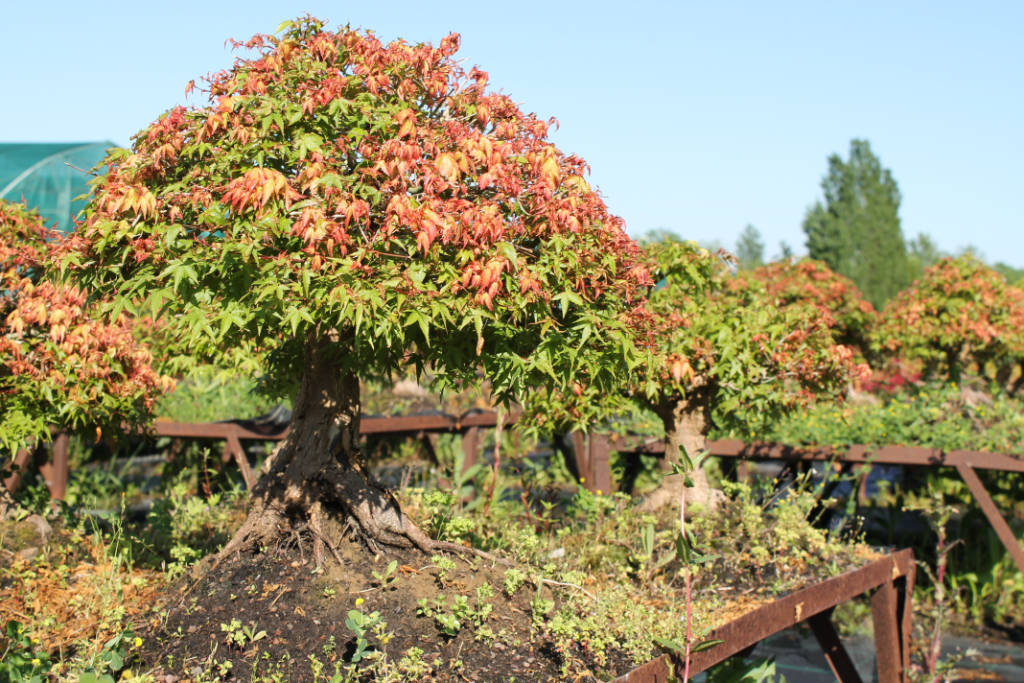
Watering
We said before that maples are species of undergrowth, so they like cool soils. Watering in summer should therefore be abundant, especially in hot weather. The rest of the time, water normally, i.e. when the top of the substrate is dry.
Watering is certainly the most difficult technique for a beginner to master. To have a nice branching, small leaves and short internodes, it is necessary to avoid excess water in spring. At this time of year we often have rain. If your maple tree is construction this is not a problem, you want to "make wood". But if you are in the refinement phase, i.e. you are looking to obtain a tertiary branching, you must manage the water supply at the risk of promoting significant growth and therefore long internodes.
So, if you're working on branching, shelter your maple trees from the rain and water just enough.
Substrate & Repotting
Bonsai maples like cool soils with a good share of organic matter (we use composted pine bark). Avoid overly draining soils consisting only of pumice or pozzolana, as they do not retain enough moisture. You need a cool but also draining soil, maples don't like to have their roots bathed in water. Pure potting soil is therefore also to be avoided.
Choosing the right substrate is something that is specific to each hobbyist, as it matches your growing conditions, your geographical location, where the trees will be placed. Sometimes it seems complicated because on the internet you can easily read everything and its opposite. Take 1/3 composted pine bark and 2/3 draining substrate as a base, and see how your maple trees behave. If the soil dries out too quickly or is still wet, adjust the amount of organic matter for the next repotting.
Repotting is done in the spring, from the moment the buds swell and the first leaves appear. Prefer to repot later rather than earlier, so avoid repotting in winter or worse in the fall. The right time is when the flow of sap has started to flow through the tree, that root activity has resumed. The cuts will heal faster and new roots will quickly appear to replace the ones that have been cut. We often repot maple trees when they are already in leaf, without any problem (but don't do that in May either!).
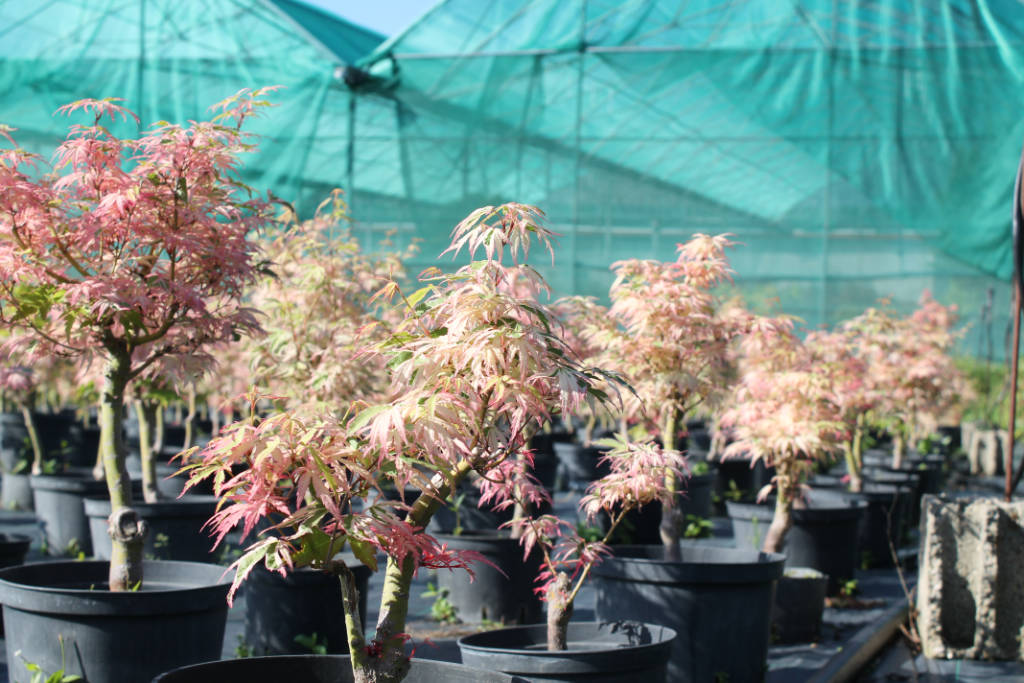
Fertilization
How and when to fertilize a bonsai maple tree is also a question that may seem complicated. The real question to ask is: why fertilize? A tree doesn't need fertilizer to live, it's just a way to give it a little boost, make it grow faster. Once this is understood, we can distinguish 2 cases:
- Your bonsai is in the process of being formed, you need to form new branches, make them bigger, or thicken the trunk. In this case, you should fertilize regularly, from the first growth in spring until autumn, putting fertilizer every month;
- You want to refine the branching of your maple, have shorter internodes, small leaves. It is therefore necessary to be light on fertilization, to slow down growth. Only start using low-nitrogen fertilizer at the beginning of summer, and fertilize with low-nitrogen fertilizer by 2 months apart
So it's important to understand that you can't develop the main structure and the branching at the same time. You have to make a choice, it's either one or the other, hence the interest in buying directly a bonsai whose trunk and main branches are already formed.
At the nursery we use both organic fertilizer and chemical fertilizer with low nitrogen (lower value of N, and higher value of P and K). The nitrogen will promote growth while the other compounds will strengthen your bonsai, and give it beautiful foliage colors.
When and how to prune a maple tree?
The term pruning actually encompasses several techniques with different objectives and time periods:
- Structure pruning is done during the winter, it consists of removing branches or twigs in order to improve the structure. The leaves have fallen, so you can see all the branches well. Eliminate any that intersect, point upwards or downwards. It is also important to keep only two tees at each intersection. Shorten the year's shoots at the first internode so that you have a compact branching.
- Spring pinching is only practiced on maple trees for which you want to work on tertiary branching. When the bud opens, when you see the first leaves coming out, it's time to prune (either with fine scissors or simply by breaking it with your fingers, hence the name pinching). This technique aims to weaken the first shoot, which is very vigorous, and produce a second one with shorter internodes. The pinching period is spread over several days for the same tree because not all the buds will open at the same time. So be careful!
- Maintenance pruning, which consists of pruning the shoots as soon as they have developed 5 to 7 pairs of leaves. With sharp scissors, cut to the first pair of leaves.
- Defoliation is the process of removing all the leaves to produce new, smaller leaves. Honestly, this is a technique we don't recommend because it weakens the tree. We prefer partial defoliation, which consists of removing every other leaf. If you have large leaves, you can even cut them in half. The objective is to bring light inside the bonsai, and thus promote budding at the very very top of the trunk.
To go further on the subject, see: how to prune a Japanese maple.
When pruning your bonsai maple, you should also consider the characteristics of the species. A palmatum is not a burger. Palmatum maples (except maybe the Kiyohime variety) should have very light foliage, you should be able to see the sun coming through the structure. A burger has much denser foliage and therefore branching.
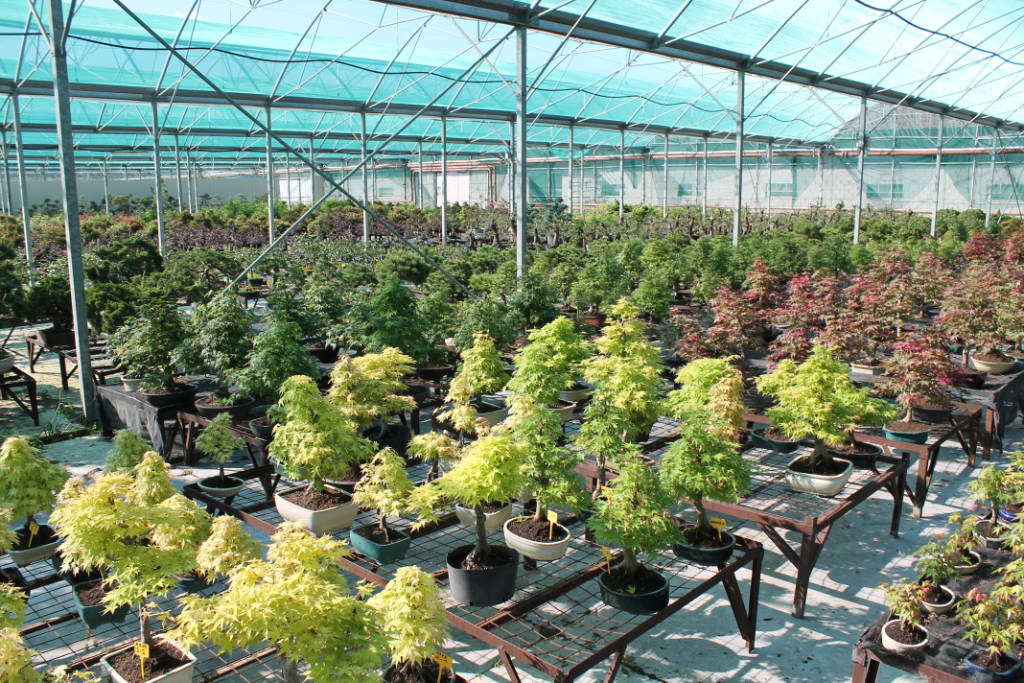
Can you tie a maple tree into bonsai?
Usually not. On a young plant, you can lay wire to place the main branches and prevent them from pointing too upwards. Then it is built more by pruning.
Tying a maple tree should be avoided because as soon as the wire begins to tighten the branch, it marks very easily and these traces take years to disappear. Often more than 10 years, and if the thread has bitten into the bark, these marks will never disappear. In addition, wood is very brittle, it is impossible to bend a branch without it breaking.
However, it is possible to lay a little wire if you want to position small branches. For example, if you want to fill a gap in order to improve aesthetics. But you have to be very careful. Lay the wire at the end of winter, very loosely so that it doesn't get tight on the bark. As soon as you see that the branch has grown, remove it to avoid marks.
We've come to the end of this long guide to maple trees in bonsai! There's so much to talk about and it's really a tree we enjoy in our nursery. We have been growing them for over 30 years, in many varieties, both large and small. If you're looking for a bonsai to work with, you're sure to find one that will hold a special place in your collection!
» See our selection of maple trees in bonsai, direct from the nursery


 Production of French Bonsai
Production of French Bonsai











































